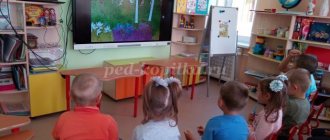Produces a strong and long-lasting air jet
An important role for setting the sound [P] is played by the correct setting of fixed breathing.
A strong, targeted air stream should pass through the articulatory organs. This means that you need to teach your child to breathe and speak correctly at the same time. Often this is not so easy to do. With the help of the following series of exercises, you will understand how to correctly position your tongue followed by the development of a targeted air stream in the middle of the tongue: 1. Place your tongue in the “Pancake” position (see description above) and blow forcefully on it with your voice turned on. When the air vibrates, the tongue will vibrate.
2. “Snowflake”: place a small piece of cotton wool on the tip of your nose and take a deep breath through your nose. Place the tongue in the “Spoon” position (see description above). We press our tongue to the upper lip and forcefully exhale air from the mouth onto the tip of the tongue. A piece of cotton wool should fall off your nose.
3. We bring a scrap or piece of paper to our nose and aspirately pronounce the sound [D]. When pronouncing each sound [D], a piece of paper should be shaken by a strong stream of air.
Methods for obtaining STD-R
Storing information about work activities in electronic form provides access to it at a convenient time, allows you to quickly draw up the necessary document and does not require mandatory interaction with the employer.
An employee can independently obtain the necessary information in his personal account on the Pension Fund website or on the State Services portal. The generated electronic document is printed or saved as a file. And if necessary, it can be opened and shown directly on the website, for example to a potential employer.
The paper version of the form will be issued to:
- employers at last place of work;
- Pension Fund;
- MFC.
At the same time, you can contact both the Pension Fund and the MFC in any region of Russia.
Setting the sound [P] from the sound combinations [DR] or [TR]
Children with bilingualism should not try to make the sound [P] by imitation, since they often begin to use a “small tongue” instead of the tip of the tongue (uvular sound [P]), or the root of the tongue that comes into contact with the soft palate (velar sound [P] ). The most effective way to set the sound [P] is to use auxiliary sounds [T] and [D] , which repeat the position of the tongue and the direction of the air. Here are several options for setting the sound [P] using auxiliary sounds:
1. You and your child recall the “Accordion” exercise (see description above), when you attach your tongue to the hard palate and hold it there. Open your mouth well so that the frenulum stretches as much as possible. Using two thumbs, lift the wide edges of the tongue towards the upper lateral teeth (the middle of the tongue and the frenulum remain free). Ask your child to take a deep breath through his nose and forcefully exhale through his mouth with his voice turned on. The child’s tongue should “swell” and you will hear something similar to [TJ]. With repeated repetition and a gradual increase in the pressure of exhaled air, you should hear a combination of sounds [TP]. Make sure that the tip of the tongue vibrates and the edges of the tongue fit snugly against the upper lateral teeth.
2. Mechanical production of the sound [P], which requires a child’s finger or any rounded flat stick. A finger or stick should be placed under the tongue from below (under the tip of the tongue, in no case under the root of the tongue!) and give it an oscillatory movement - from side to side, while simultaneously pronouncing the syllable [T-YOU] or [D-DY] many times in a row . Make sure that your tongue is wide and very tense, and your lips are in a smile. The tongue will swing along with the finger. In this position, you can compare the tongue to a string. If the string is tense, then by touching it we cause it to vibrate. The string begins to sound. But if the string is loose, there will be no sound.
As soon as the child manages to pronounce a combination of sounds correctly and clearly, you can move on to a longer pronunciation of [DR] and [TR] in syllables, words and sentences using your fingers (or a stick) and strong air pressure.
- Syllables: tr-r-a, tr-r-s, tr-r-o, tr-r-u tra-t tra-tru tra-tra tro-tru tro-try tru-try
- Words: grass, ladder, grass, track, cable, touch, troika, labor, tube, difficult
- Words (with emphasis on the syllable): ma-trats, te-trad, ma-tros, me-tro, pa-tron, va-trushka, pe-trushka.
- Sentence: Parsley eats cheesecake. The sailor pulls the cable.
Rules for registration of STD-R
You can create a work activity form in either paper or electronic form. In the first case, under the main table there will be a signature (with transcript) of the authorized person and a seal (if the party generating the document has one). The electronic version will need to be certified with a qualified electronic signature.
Accordingly, the form can be handed to the employee or sent by mail (including electronic mail). If a current employee needs the STD-R form, he himself asks the employer to draw it up. Upon dismissal, this document must be issued in paper or electronic form.
For a sample of filling out the STD-R information, see our website. And you will find line-by-line explanations for filling out the document in the material “How to fill out the STD-R form from 03/07/2020” of the Guide from ConsultantPlus, having received free access.
The procedure for filling out documents related to the electronic work book is described in detail in the Review from ConsultantPlus. Study the document by getting trial access to the legal reference system for free.
Sample of filling out information according to the STD-R form
Automation of sound [P] in syllables and words
Once the long pronunciation of the sound combination [DR] and [TR] has been worked out, you can move on to the isolated pronunciation of the sound [P]. You will hear for yourself that the child begins to pronounce the sound as soon as the tongue muscles get used to the desired position and become stronger. The need to use auxiliary sounds will disappear. If you still hear the use of auxiliary sounds [D] and [T], this means that the muscles of the tongue are not yet sufficiently developed. In this case, continue to perform the previous set of exercises in combination with more careful pronunciation of syllables and words with auxiliary combinations of sounds [D] and [T].
Performance by R.R.R.
The whole performance is in one breath. We, the audience, were spellbound, like sleepwalkers, staring at the stage without stopping. This magical whirling of the stairs, so strikingly reminiscent of St. Petersburg, seemed to take the audience captive and did not let go until the end of the performance. I don’t even remember that during the action, someone’s cell phone – as always inopportunely – rang. This did not happen. The hall froze. I really liked the performance. I went to see Sukhorukov, but I want to note not only his performance, which is undoubtedly very interesting, but also the performance of the young actors who have come to the theater in the last two years - Alexei Trofimov (Raskolnikov) and Anastasia Pronina (Sonya). The stage design of the play and the scenery are interesting. The production was announced as “based on”, and indeed there were deviations from Dostoevsky’s text, but everything was in the spirit of the writer and looked very organic. However, this is what interested me and made me think. The action begins with Raskolnikov sitting and feverishly typing an article - the same one that he will take to the editorial office of the magazine. So, actually, I was interested in the typewriter. The fact is that Dostoevsky wrote his works by hand, and Raskolnikov also wrote his article by hand. Although the typewriter had already been invented in the 19th century, it was not in widespread use. Therefore, her appearance on the stage of the play made me think. Maybe I'm wrong in looking for some meaning in this. I am a simple person, far from the sphere of theater, where I know how performances are invented. Maybe it’s like this: the director, the scriptwriter and the actors sat down, thought about what to do so original, which is not in other productions, and decided: let’s figure it out so that Raskolnikov types on a typewriter, and what is original. No sooner said than done. But it may also be that this very typewriter was conceived as the “hero” of the production, strange as it may seem. After all, she appears not only in the first scene, when Raskolnikov writes an article, then she appears in the scenes at the police station (she stands on Porfiry Petrovich’s table). And if its appearance is not accidental, then it means that it is needed for some reason, it means that there was a need to introduce a detail that could not be in the realities of the 19th century, but belongs to a later time. To be honest, I still didn’t understand why it was needed. I will only say that her appearance in the play was very organic, somehow natural, and was not perceived as dissonance. The only thing, of course, is that the typewriter on the investigator’s desk gives rise to associations with the investigative processes of the 20th century. However, whether Raskolnikov is similar to the criminals of the 20th century is a question. The introduction of a typewriter brings something new into the understanding of the novel, for example, the idea arises that Raskolnikov himself signed (or rather, typed) his own verdict when he wrote the article. And Porfiry Petrovich’s actions in this situation can only be regarded as auxiliary - he only completes this matter, puts an end to it. So, the production of the theater named after. Mossovet is extremely interesting, the acting is excellent, the scenery is beautiful, and, most importantly, it makes you think, which is very important.
Bridle trimming?
A commonly practiced method in the past that I often hear from parents to this day is cutting the hyoid ligament (frenulum). I would like to note that such drastic measures cannot always lead to the desired result - the appearance of the sound [P]. I categorically do not recommend cutting the frenulum unless there is a medical indication for it. The absence of this sound is associated with general weakness of the tongue muscles and underdevelopment of the hyoid ligament. This is why the child is not able to lift his tongue and press it tightly to the palate. Follow the tips above, and the desired results will not keep you waiting.
Good luck to you and your kids!
Speech therapist Alena.
SZI-TD or STD-R - what to use
Starting from 2022, Russia will introduce work books in electronic form. All information about the employee’s work activity will be accumulated by the Pension Fund based on information from employers’ reports submitted to:
- monthly (from 2022) - on the work activities of employees;
- in connection with specific events (from 2022) - on hiring and dismissal.
And workers will now be able to receive information about their work activities using a special form, which can be presented if necessary, for example, when applying for a new job.
The form contains all the data familiar to a paper work book:
- information about the employee;
- information about the employer;
- dates of events related to his service;
- an indication of the essence of these events;
- reference to the details of the document that recorded the event.
Therefore, the main place in the form is occupied by a table with a set of columns reserved for indicating relevant information in them.
Initially, two draft forms were developed for these purposes:
- from the Pension Fund of Russia - form SZI-TD;
- from the Ministry of Labor - form STD-R.
ATTENTION! Some banks offer a reduced mortgage rate, subject to the borrower providing information about his work history. This data can be requested from the Pension Fund of Russia using the SZI-6 form. This document contains information about the insurance premiums accrued and paid by each employer. If the insured person's contributions were not paid by the employer, information about them and the insurance period for this period is not included in the SZI-6 certificate. Claims for length of service actually worked, but not included in the insurance period due to non-payment, in accordance with current legislation (Article 18 of the Law “On Personalized Accounting” No. 27-FZ) must be attributed to the employer, whose actions can be appealed in court ok.
The STD-R form was officially approved (Order of the Ministry of Labor dated January 20, 2020 No. 23n). This is exactly what you need to use. The SZI-TD form will not be used.
Results
The transition to an electronic method of maintaining work books has led to the need to create a document that replaces them for workers.
The form of such a document was approved by the Ministry of Labor. The basis of the form is a table reflecting information usual for a paper work book. The document will be filled out automatically based on the data stored in the Pension Fund. It can be issued in paper or electronic form. You can find more complete information on the topic in ConsultantPlus. Free trial access to the system for 2 days.
Three ways to stage
Is your baby able to do articulation exercises? You can proceed to the next stage - sound production. The speech therapist has mechanical techniques in his arsenal.
- Spatula and nipple technique. The doctor places the pacifier on a wooden spatula. The student assumes the “Airplane drone” position. The specialist makes rapid movements under the tip of the tongue until it begins to vibrate. Movements - up and down, left and right. This technique is more effective if the baby's head is on the doctor's lap.
- Vibration - using paper. A wad of paper is placed on the tip of the tongue, a string is tied to it so that the paper does not fall on the floor, and it is given to the baby. He hides his tongue behind his upper teeth and tries to blow the paper off his tongue.
- Repetitions of the sound "d". The student sits in front of a mirror, opens his mouth slightly, places the tip of his tongue at the beginning of the upper teeth and quickly repeats “d-d-d-d.” Then he connects “d” with vowels: “d-d-a”, “a-d-d” and then the rest of the letters.
At this time, the specialist places a spatula under the front edge of the tongue and carries out frequent oscillatory movements. This contributes to the pronunciation of the rumble that is characteristic of vibrant.





